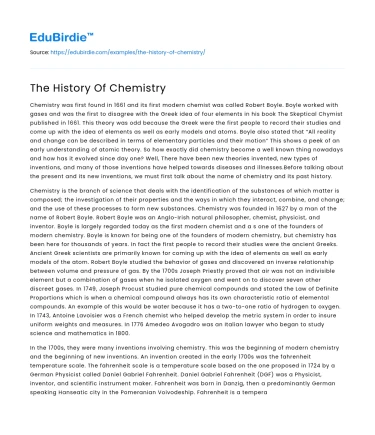Chemistry was first found in 1661 and its first modern chemist was called Robert Boyle. Boyle worked with gases and was the first to disagree with the Greek idea of four elements in his book The Skeptical Chymist published in 1661. This theory was odd because the Greek were the first people to record their studies and come up with the idea of elements as well as early models and atoms. Boyle also stated that “All reality and change can be described in terms of elementary particles and their motion” This shows a peek of an early understanding of atomic theory. So how exactly did chemistry become a well known thing nowadays and how has it evolved since day one? Well, There have been new theories invented, new types of inventions, and many of those inventions have helped towards diseases and illnesses.Before talking about the present and its new inventions, we must first talk about the name of chemistry and its past history.
Chemistry is the branch of science that deals with the identification of the substances of which matter is composed; the investigation of their properties and the ways in which they interact, combine, and change; and the use of these processes to form new substances. Chemistry was founded in 1627 by a man of the name of Robert Boyle. Robert Boyle was an Anglo-Irish natural philosopher, chemist, physicist, and inventor. Boyle is largely regarded today as the first modern chemist and a s one of the founders of modern chemistry. Boyle is known for being one of the founders of modern chemistry, but chemistry has been here for thousands of years. In fact the first people to record their studies were the ancient Greeks. Ancient Greek scientists are primarily known for coming up with the idea of elements as well as early models of the atom. Robert Boyle studied the behavior of gases and discovered an inverse relationship between volume and pressure of gas. By the 1700s Joseph Priestly proved that air was not an indivisible element but a combination of gases when he isolated oxygen and went on to discover seven other discreet gases. In 1749, Joseph Procust studied pure chemical compounds and stated the Law of Definite Proportions which is when a chemical compound always has its own characteristic ratio of elemental compounds. An example of this would be water because it has a two-to-one ratio of hydrogen to oxygen. In 1743, Antoine Lavoisier was a French chemist who helped develop the metric system in order to insure uniform weights and measures. In 1776 Amedeo Avogadro was an Italian lawyer who began to study science and mathematics in 1800.
Save your time!
We can take care of your essay
- Proper editing and formatting
- Free revision, title page, and bibliography
- Flexible prices and money-back guarantee
In the 1700s, they were many inventions involving chemistry. This was the beginning of modern chemistry and the beginning of new inventions. An invention created in the early 1700s was the fahrenheit temperature scale. The fahrenheit scale is a temperature scale based on the one proposed in 1724 by a German Physicist called Daniel Gabriel Fahrenheit. Daniel Gabriel Fahrenheit (DGF) was a Physicist, inventor, and scientific instrument maker. Fahrenheit was born in Danzig, then a predominantly German speaking Hanseatic city in the Pomeranian Voivodeship. Fahrenheit is a temperature scale that bases the boiling point of water at 212 and the freezing point at 32. This was huge for chemistry since this invention is still being used in some places today. These places that still use Fahrenheit are states in the United States and some Caribbean countries.
Another chemistry invention that is still used to this day is the invention of an x-ray. X-rays make up x-radiation, a form of high energy electromagnetic radiation. X-rays were invented in the year 1895 by Wilhelm Conrad Roentgen, who was a professor at Wuerzburg University in Germany. Wilhelm discovered this creation when he was working with a cathode-ray tube in his laboratory, Roentgen observed a fluorescent glow of crystals on a table near his tube. The tube that Roentgen was working with consisted of a glass envelope (bulb) with positive and negative electrodes encapsulated in it. The air in the tube was evacuated, and when a high voltage was applied, the tube produced a fluorescent glow. Roentgen shielded the tube with heavy black paper, and discovered a green colored fluorescent light generated by a material located a few feet away from the tube. This is also an important invention since kt is also used to this day.
In conclusion, chemistry has been in this world for a long time now and new inventions has been there as well. Every day new ideas are made and are used to create new ones. Both the fahrenheit temperature scale and the x-ray systems were created in the 1700s through the 1800s and are both still being used to this date. Chemistry and its past is very important to know because it's the past of a subject which is studied by schools around the world and has been in this world for a very long time.






 Stuck on your essay?
Stuck on your essay?

